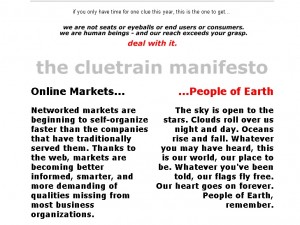While a significant proportion of you were tucked up in bed, I braved Sunday morning buses and tubes to attend the Guardian Masterclass on building online communities. It was a great day, packed with engaging and expert speakers.
Joanna Geary’s talk focused on the how businesses could harness the power of online communities.
Being human
When you get down to it, to create a successful online community, businesses need to realise that they’re not dealing with eyeballs or click-throughs, but people. People who have busy lives and don’t need to spend their downtime engaging with branded content. Joanna mentioned the cluetrain manifesto which is all about bringing the human touch back into business communications.
Know why you’re doing it
Don’t create a community, or start a social media account, until you know why you’re doing it:
-
- Who do you want to create conversations with? What do you want from them?
- Ask people to contribute their expertise and knowledge, not just post for the sake of it.
- Why would they want to talk about your business? What do they get from the relationship?
- What are their passion points?
- Decide how you’re going to measure ROI. It may not be traffic to your site, but engagement.
“Ultimately you need to have (and know the) purpose for a community to exist. Ask yourselves constantly ‘Why are we doing it?’ #socialconf — Ollie Drackford (@OllieFD) September 22, 2013
Case studies
Joanna highlighted some great ways that companies and organisations are creating communities:
Moo.com uses flickr so people can show off and share their business card creations.
Caine’s arcade went from one customer to a $233k college fund from a YouTube video.
.@GuardianJoanna showcasing Caine’s Arcade as story of power online communities: http://t.co/XCkku8zvQl #socialconf — Hannah LDN (@hrwaldram) September 22, 2013
Giff gaff is a business built around the concept of community.
Macmillan uses its online community to provide support to people who don’t have others to lean on.
Never forget…
Running a community, or keeping social media channels updated, will never stop being hard work.
Something people working with online communities should never ever say- @GuardianJoanna: #socialconf pic.twitter.com/19kao7h1Nx
— Hannah LDN (@hrwaldram) September 22, 2013
–
Next, the Guardian’s Laura Oliver discussed building communities around content.
The Guardian uses Guardian Witness to collate content from members of the community. All user generated content is verified before going live on the site. Laura spoke of two different kinds of communities:
-
- Transient communities, that come together around a major event (for example, those people who want to share their experiences during a terrorist attack)
- Long-term communities that form around an ongoing story – such as the debate over unpaid internships.
Important point from @LauraOliver: you need to keep communicating with your community – not just when you want something #SocialConf
— Joanna Geary (@GuardianJoanna) September 22, 2013
For the more established communities, it’s important to keep them engaged over the long-term. Reward them for contributing (even just a simple thanks).
The more effort they need to put into the content they submit, the more appreciation you should show (it’s easy to share a twitpic, less easy to film a five minute video especially for the site).
Diversity of sources is becoming important as community content grows. #PR #SocialConf
— Gemma Storey (@gemma_m_storey) September 22, 2013
It’s not possible to be an expert on everything, but together, communities can share knowledge and help each other with expertise and different perspectives. The community is stronger when it encourages people to contribute their talents.
–
We then heard from the editor of Buzzfeed UK, Luke Lewis. He discussed how content creators can increase the shareability of their work.
@lukelewis proves he works for Buzzfeed with a photo of him with Grumpy Cat! #SocialConf pic.twitter.com/CAfBhPrqY1
— Masterclasses (@guardianclasses) September 22, 2013
His advice included:
Write for people, not SEO. #SocialConf
— Gemma Storey (@gemma_m_storey) September 22, 2013
And
Ignore mainstream, go niche to go viral #SocialConf
— Tamara Littleton (@tlittleton) September 22, 2013
Not all Buzzfeed articles ‘go viral’, and topics that are popular in one territory may not catch on in another. For example, 27 Middle-Class Problems was a hit in the UK, but not in the US. Luke pointed out that this could be because us Brits like to poke fun at ourselves. I think it could also be because –traditionally – class isn’t a big issue in America.
If you want content to go viral, it helps if:
- It’s original.
- It has a visual element.
- You don’t have to click through a gallery – it’s all on one page.
- It’s easily sharable.
- The article creates a positive emotion (snark brings in the views, but doesn’t get shared).
- You keep a close eye on the data – what do people want?
The drivers of social sharing from @lukelewis #socialmedia #SocialConf pic.twitter.com/hwMbeD4TLx
— Tamara Littleton (@tlittleton) September 22, 2013
To create a viral article, you need to do the opposite of what you’ve been trained to do.
–
The final speaker was Sarah Drinkwater from Google+ Local, who talked us through engaging influences and creating an audience of advocates.
Sarah distinguishes between power users and influencers. Power users are the stalwarts of your community, the people that will stick with you, email you when they’re not happy, and contribute a lot of time to the community. Influencers, are the bloggers, thought leaders and maybe celebrities, that you want to reach.
A tiny fraction of the community is made up of power users.
80% of site visitors never come back. @sarahdrinkwater #SocialConf
— Gemma Storey (@gemma_m_storey) September 22, 2013
Power users are motivated by:
- Tangible rewards – where they get something out of contributing.
- Intangible rewards – the feeling the get from contributing.
- Altruism – they enjoy helping others.
- Utility – they find the community useful.
You can reward power users by:
- Providing them with badges for contributing.
- Giving them moderator status.
- Providing offline rewards.
- Giving them specially community related rewards – like Amazon Vine.
Think about arranging face-to-face meet-ups to deepen the engagement.
For influencers, think about creating influencer only events. But, Sarah points out, don’t spam your list of desired bloggers. Do your research. Ask yourself why they would want to come to your event.
Brands & bloggers: it’s a relationship. What do you want from them & what will they get from it? #SocialConf @sarahdrinkwater
— Gemma Storey (@gemma_m_storey) September 22, 2013
–
The day ended with a panel Q&A session on community moderation featuring Reddit moderator James Maw, Guardian head moderator, Marc Burrows, and Tamara Littleton, CEO of social media management agency (and Carrot client) eModeration.
We heard that moderation guidelines vary from site to site. What’s acceptable on the Comment is Free section of the Guardian would not get through the moderation queue on a children’s entertainment site.
Moderation is about much more than filtering content. @tlittleton#SocialConf
— Gemma Storey (@gemma_m_storey) September 22, 2013
Moderation needs to be based on a strict set of community guidelines, and enforced fairly and consistently, for the community that it serves to protect.
As you can see, the day was packed with useful information. It proved to be a great way to kick-off Social Media Week.







